Great case I had in December. Overall good month, but this case was especially interesting, and humbling. It combines the excitement of chest pain, the enigma that is leg weakness, and humbling realization of a life threatening diagnosis.
Working in the ED one day and the psychiatry intern goes to see a patient. Routine patient, who had presented with right leg tingling and weakness that made it all the way to the back of the ED. Bed 15. Basic labs pre-ordered as well as a chest X-ray for a brief episode of chest pain that the patient told triage. Of course, the sixth vital sign, an ekg. Intern is with the patient for about 5 minutes and returns. He tells me that he is concerned that the patient is sick and wants me to see the patient sooner than later. He is concerned for possible stroke due to right leg weakness and pain. I tell him of course and I go see the patient.
HPI: 58 y/o AAM with hx of seizures on Dilantin but no other medications or PMH presents with chief complaint of right lower leg pain and tingling. Patient states that while at work today, he was lifting boxes and felt a sharp chest pain that started in the middle of his chest and radiated to between his shoulder blades. It then shot to his pelvis and went away. He went back to work for about 10 minutes then started to have right leg pain. He tried to drive to the hospital, but had to stop and call an ambulance due to sever RLE pain. All other symptoms had resolved at this point. No n/v, diaphoresis, dizziness, loss of bowel or bladder.
Pertinent Hx: NKDA, 30yr pack hx of smoking, dilantin.
Vitals: BP: 148/62, HR 66, RR 18, O2 100% T 98.5
Significant Physical Exam –
RRR, no m/r/g, CTAB, abd soft, nt, nd, no bruit, no pulsating mass
RLE strength 4/5, LLE 5/5.
No DP, PT, popliteal, or femoral pulse in the right leg.
At this point I was concerned. I excused myself and got the bedside ultrasound. In my head I wondered was this just a arterial occlusion, or was this something greater?
Well this is when I started to sweat. I tell the patient what I think my diagnosis is, and head back to my desk to get orders going. At this time I review the labs and chest X-ray.
CBC – WNL, CMP – K 3.3, UA WNL, Troponin Neg, Tox Screen Neg, Coags neg.
Chest Xray –
Any more concern? At this point I ordered a CTA of the Chest/Abdomen/Pelvis as well as called the surgery team. I wanted to get them involved early in the case that the patient deteriorates. I assessed the patients blood pressure at at the time was 130/60 and HR 58. I got the nurse to get the patient to the CT scanner as well as discussed with the trauma team. At this time patient had stable vital signs and pain controlled with morphine. Trauma evaluated and the CT resulted.
We now have our diagnosis. When patient got back from CT scanner, his blood pressure was increasing and now 150/80 and HR 68 with increasing pain.
Esmolol gtt was started, arterial line place, and the patient was transferred to another local hospital to undergo cardio-thoracic surgery for repair.
Diagnosis – Aortic Dissection from the level of the aortic valve down through the bifurcation of the iliac arteries. From the one slice, you can see he had no flow to the right leg. CTA demonstrated some collateral from the gastrics, but overall no flow.
Patient outcome – survived surgery. Otherwise have not been able to follow-up past that time. I shared this case because I feel it is a good representation of a case where easy bedside diagnostics can give you the diagnosis early and lead to your diagnosis. With the chest X-ray as well as the bedside ultrasound, we knew what the patient had. The CTA was just icing on the cake. Never be afraid to use the ultrasound. If it had been negative, this could have gone a completely different direction. Credit to the psychiatry resident for getting me involved early.
Use the ultrasound. Use it early. Diagnose early.
![Room9er ["Room Niner"]:](https://room9er.com/wp-content/uploads/2020/03/cropped-Screen-Shot-2020-03-08-at-3.16.16-PM.png)
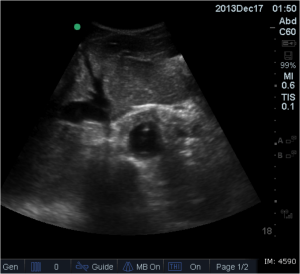


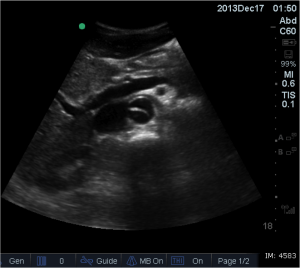
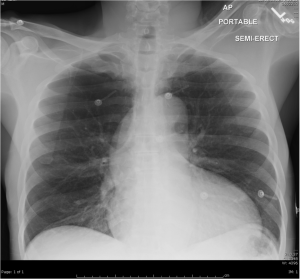
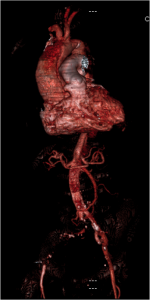

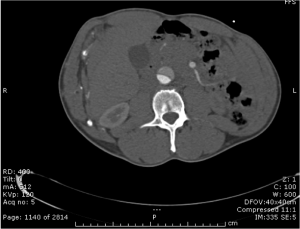

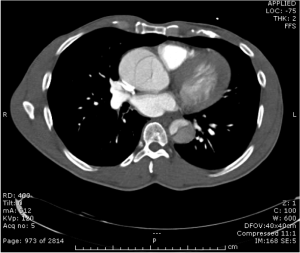
Great case Hugh…textbook images of dissection on BSUS. Great pickup!
Pete
Nice! That’s strong work. I try to keep it in my head anytime you have any Neuro symptoms mixed in with chest pain, worth going down that pathway.
I don’t like congratulating you often but this is an awesome case. Subtle findings, VSS inconsistent with the case. CXR is concerning, neuro findings and vascular findings are concerning. Great pick up, keep your eyes open people!
The use of abd ultrasound has drastically changed diagnosis of AAA and dissection involving the abdomen.
I would have loved to take a look at the aortic arch. The cardiac probe is placed at the sternal notch and aimed inferiorly. Can see the arch pretty well. Practice on normal people so you can appreciate an intimal flap on dissection patient. Ill attach a decent article that unfortunately has no images up in Hugh’s post. And see the link below.
Follow up question, why would one ultrasound the heart in this patient, ie what are the ways aortic dissection kills you?
http://123sonography.com/node/755
Since all the Big Names (excluding Neagum) were commenting, I figured I needed to reply.
The two coronary arteries originate from the left side of the heart at the beginning (root) of the aorta, just after the aorta exits the left ventricle. The left coronary artery originates from the left aortic sinus, while the right coronary artery originates from the right aortic sinus. No artery arises from the posterior aortic sinus. The coronary arteries are classified as “end circulation”, since they represent the only source of blood supply to the myocardium; there is very little redundant blood supply, which is why blockage of these vessels can be so critical.
Aortic insufficiency (AI) occurs in half to two-thirds of ascending aortic dissections, and the murmur of aortic insufficiency is audible in about 1/3 of proximal dissections. The intensity of the murmur is dependent on the blood pressure and may be inaudible in the event of hypotension.
There are multiple etiologies for AI in the setting of ascending aortic dissection. The dissection may dilate the annulus of the aortic valve, so that the leaflets of the valve cannot coapt. Another mechanism is that the dissection may extend into the aortic root and detach the aortic valve leaflets. The third mechanism is that if there was an extensive intimal tear, the intimal flap may prolapse into the LV outflow tract, causing intimal intussusception into the aortic valve preventing proper valve closure.
Myocardial infarction occurs in 1–2% of aortic dissections. The etiology of the infarction is involvement of the coronary arteries in the dissection. The right coronary artery is involved more commonly than the left coronary artery. If the myocardial infarction is treated with thrombolytic therapy, the mortality increases to over 70%, mostly due to hemorrhage into the pericardial sac causing pericardial tamponade. Because aortic dissection may present to the emergency room physician similar to a myocardial infarction, the physician must be careful to make the proper diagnosis prior to initiating treatment for myocardial infarction, since the treatment regimen for myocardial infarction can be lethal to an individual presenting with aortic dissection.
70918248
References:
another name for physiological risk is safety risk.
Over half a century later, quite a few ladies have used Anavar anecdotally and in research.
Now it’s widely thought of that doses in the range of 5–10 mg produce noticeable outcomes while inhibiting virilization. Users’ genetic makeup will determine the extent of hair loss they will experience.
Or, extra specifically, how delicate they are to dihydrotestosterone.
There just isn’t a vast amount of knowledge regarding the relationship between anabolic steroid use and kidney damage.
Nonetheless, Anavar is exclusive in this respect, being mostly metabolized by the kidneys.
Lean muscle gains will differ considerably among girls, but over a 6-week cycle,
some females can see excellent features of up to 5-10lbs, even whereas dropping some body fat.
400mg weekly of Trenbolone Acetate for eight weeks will compound substantially on the outcomes of Anavar.
Extra skilled customers of Anavar often lengthen to the 50-70mg daily dose while sticking to an 8-week cycle.
A testosterone ester should also be included in an intermediate cycle, and once more, the
dosage will rely upon what you’re making an attempt to attain and whether it is a hardcore
slicing cycle. Nevertheless, extra advanced users will go additional than this, utilizing one or more other compounds at performance-enhancing doses alongside Anavar.
This is a helpful strategy, particularly for slicing and shredding
(where Anavar excels).
If you are wondering how some health fashions and celebrities maintain their
good physiques, Anavar may just be their secret.
Inform your healthcare provider of any supplements you
take to stop potential interactions. Crazybulk is a company that sells
legal steroids, they usually have an excellent reputation.
20mg every day is considered to be the maximum that women ought to take, but even this
is a excessive dose. This will offer you a beneficial every day caloric consumption; when using Anavar for cutting, scale back
your consumption by about 500 calories under the beneficial quantity.
This ought to include high-quality protein and carbs (not refined or white carbohydrates).
Loopy Bulk is our beneficial source for legal steroid alternatives, primarily based on 1000’s of
constructive critiques on verified platforms corresponding to Trustpilot and Feefo.
Oxandrin remains to be offered at present, but underneath
the recent company name Savient. Generic Anavar is now produced and offered, with the orphan drug designation expiring,
dismantling BTG’s monopoly. Nonetheless, due to this previous elevation in worth, in addition to excessive demand for Anavar and only some labs on the
earth producing it, Anavar still remains expensive
right now.
Vigilance and enough fluid consumption are essential when exploring higher dosages, balancing the pursuit of enhanced outcomes with responsible utilization. For those in search of to purchase Anavar from reputable retailers, five
dependable sources have been recognized. Pure Anabolics and Steroid Warehouse both provide high-quality products with rigorous testing for purity.
Muscle Gain Pharmaceuticals ensures clear dosage pointers and transparent business practices.
Health Lab Supplements is understood for its stable trade monitor document, whereas Elite Performance Gear provides detailed product data
and lab outcomes. Every vendor prioritizes buyer satisfaction,
high quality assurance, and discrete transport strategies, confirming your purchase
is respectable and safe.
If you’re buying steroids online, at all times go for the one that gives you value for cash.
Oxandrolone goes nicely with other steroids – testosterone,
drostanolone, etc. You can all the time seek the
assistance of with Driada medical specialists to plan the best
cycle to realize your targets. Originally, oxandrolone was formulated to assist HIV-infected
patients who were weakened, as nicely as these with Turner’s syndrome, anemia,
burn recovery, and people needing to strengthen their bones.
It rapidly found a place within the bodybuilding and fitness community, the place it began to be used actively.
The “Testosterone & HGH” subreddit is a vibrant group dedicated to exploring the pivotal role of hormones like
Testosterone and Human Development Hormone (HGH) in health, health,
and overall well-being. It’s a spot the place individuals can come together to
share experiences, focus on the latest analysis & info, and
evaluation health dietary supplements that influence hormonal balance.
UGL sources can price more or less than this – prices range significantly throughout
suppliers, and so does the standard. This is one
reason why men, in particular, will choose to not use Anavar – the
excessive value combined with the popularity it has of
being “too mild” can definitely put you off.
Still, we should always remember that even a 4-week
cycle of Anavar can produce results, which is ready to maintain costs down somewhat.
Be conscious of the laws in the nation you’re dwelling in or staying
in when buying and utilizing Anavar. Having a PCT plan ready to go for the end of your Anavar cycle
is an easy method of avoiding low testosterone.
Anavar has a benefit here and may actually have a extra
constructive effect on your tendons and joints.
Due To This Fact, as a outcome of Anavar doesn’t usually cause
the above side effects, it is generally taken by females trying
to construct muscle and burn fat. Our experience and scientific studies
point out that elevated liver enzymes generally return to regular following cycle
cessation (11). Based on our checks, Anavar is certainly one of
the greatest steroids in regard to toxic unwanted
effects.
Toxicity – As Anavar is consumed orally it should pass through
the liver, and although Anavar is taken into account a light steroid you must be cautious.
There must be no alcohol consumed whilst taking
the drug and it’s suggested to seek the advice of your physician if you are taking any present
medications. Even although anavar is classed as a very
mild steroid, in a examine carried out in 1999 it was shown that just 15mg of the drug decreased natural testosterone levels by practically 40% (8).
One concern some athletes/bodybuilders can experience when in a calorie
deficit is muscle loss. A good instance of that is whenever you see men/women on stage who look
really lean and shredded however have lost loads of muscle measurement in the construct up
to the present. #1 Enhance In Energy – customers expertise distinctive levels of power when taking anavar,
making it top-of-the-line steroids to take if you’re trying
to set new PR’s in the gym.
Anavar is formally classed as a schedule III managed substance in the united
states However, there are corporations who promote spinoff
variations (compounds almost identical) to anavar online.
However, if you do go down this route don’t purchase from
companies with poorly designed websites or ones which don’t listing
their address, as you could get scammed.
References:
names of oral steroids